When talking about the least or most durable roofs for Northern Colorado, we mean with respect to anything that threatens the longevity of it, such as wind, hail, fire, sun or UV radiation, rain, snow, and the general degradation of the roof. Others things that affect the longevity of a roof include the quality of the materials, if they were installed correctly, and if they were maintained. In this article, we’re going to set those things aside, and assume average quality, correctly installed, and well maintained roofs.
Below are popular roofs ranked with respect to their resistance to the following elements:

Snow Answer: The most durable roof is standing seam and stone-coated metal shingles and shake. The least durable roof is wood shake and traditional asphalt shingles since they’re the shortest-lived.
The Most Durable Roof to Wind
Metal roofing, be it standing seam or metal shingles, offer superior wind resistance for a number of reasons. First of all, screws are used to secure them into place instead of nails. Screws offer superior holding power over nails. Secondly, metal panels or sheets have fewer seams which means fewer areas where wind can lift up the roof. Metal is stronger than other more common roofing materials, such as asphalt shingles. Asphalt shingles easily tear in wind once loose. Because metal is thinner than, for example, clay or concrete tiles, it’s more difficult for wind to grab a hold of it. This makes it more resistant to wind than these materials.
Natural slate is very heavy. On average, slate tiles weigh between 9.1 lbs/sf for 1/4″ and 18.8 lbs/sf for 1/2″ tiles. This heavy weight makes it more wind resistant than lighter roofing materials. The heavier the roofing material, the stronger a wind it takes to lift it. It is for this reason alone that makes natural slate highly wind resistant.
Concrete and clay tiles are also heavy. On average, they weigh between 9 to 11 lbs/sf. They, too, make for a great wind resistant roofing option for this reason. What makes most clay tiles less wind resistant, and some concrete tiles, is their thickness or taller profile. This taller profile gives high winds something to grab.
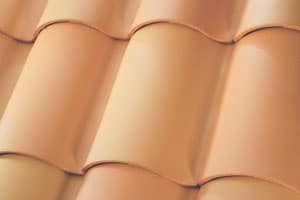
Approximate Weights of Popular Residential Roofing Materials:
- Metal: 1.2 lbs/sf
- Wood shake: 2.4 lbs/sf
- Asphalt shingles: 2.7 lbs/sf
- Concrete tile: 9.3 lbs/sf
- Clay tile: 10.8 lbs/sf
- Slate: 9.1 – 18.8 lbs/sf
Asphalt shingles offer modest wind resistance compared to other roofing options. Nails secure shingles down, which are inferior to screws. Most manufacturers produce more than one shingle line that withstand winds of at least 110mph. A professionally installed shingle will ensure the longest life possible.
Wood shake roofing is among the least wind resistant. For one, it’s lightweight. As a result, they are easily blown-off. Installers often use nails or staples to secure them to the roof deck. These fasteners have less holding power than screws, which makes them easy to remove. Wood shake also has a higher profile (thicker) than, for example, metal roofing panels. This gives wind something to grab, which makes them susceptible to wind damage.
For the most wind resistant roofing material, look for one with no gaps between each layer. For example, Westlake Royal Roofing’s concrete tiles or their stone-coated metal shingles.
If you live in Longmont, be sure to review their roofing restrictions. We’ve assembled a list of wind resistant roofing options for your convenience.
Roofs Most Resistant to Wind:
- Metal (standing seam, stone-coated metal shingles)
- Natural Slate
- Concrete or Clay Tile
- Asphalt Shingles
- Wood Shake (least resistant)
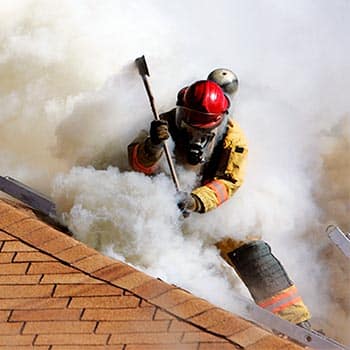
Most Durable Roof to Fire
Slate
You can’t get a more fire resistant roofing material than natural slate. Simply put, rock doesn’t burn. Slate roofing tiles carry a Class A fire-resistant rating – the highest in the industry. Slate is very heavy, however. If your roof deck is made of wood, which most are, if your house is on fire, your roof could collapse sooner than if you had a lighter roofing material, for example, metal panels. Although the most durable roofing material to fire is slate, it comes at a cost.
Standing Seam
Standing seam metal roofing panels contain no flammable substances, just like slate. Although metal doesn’t burn, it can warp if the temperature is high enough. However, because standing seam panels are slick, hot embers will slide right off. Standing seam is also very lightweight. If a fire were to start inside the home, it should stand longer than if the house had a slate roof.
Concrete Tiles
Concrete tiles also contain no flammable substances. However, some concrete roofing products have gaps between each tile, which embers can blow into. Concrete tiles are also heavy, like slate, which makes it unappealing from a stability standpoint should your walls be weakened by a fire.
Clay Tiles
Clay tiles also don’t burn. However, some clay tiles are thinner than others and can become brittle should exposed to extreme heat. Also, some clay tiles do not lay flat against one another. As a result, embers can blow-in underneath them.
Stone-Coated Steel Shingles
Metal shingles and tiles contain asphalt. Asphalt burns, which is why these roofing products are further down on our list. Some stone-coated metal shingles and tiles have a tighter fit than others, preventing embers from blowing-in underneath or between them.
Traditional Asphalt Shingles
Asphalt shingles contain asphalt which burns. Granted, the top layer is made of granules, which helps protect the asphalt from embers. Should your asphalt shingle roof lose those granules, it is now susceptible to fire, as well as water leaks.
Wood Shake
Wood shake is the least fire resistant roofing option because wood burns. It is naturally flammable. Treated wood shake is better, but requires regular treatments, which is expensive.
The best fire resistant roofing material contains no flammable substance and won’t have any gaps between each layer. No gaps means no place for embers to blow into. See some of Westlake Royal Roofing’s products.
Most Durable Roofs to Fire:
- Slate (most resistant)
- Standing Seam, Corrugated
- Concrete Tiles
- Clay Tiles
- Metal Shingles
- Asphalt Shingles
- Wood Shake (least resistant)
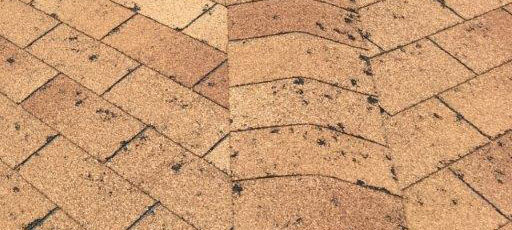
Most Durable Roof to Hail
Metal
Metal roofing is the most hail resistant roofing option available today. Corrugated panels, in particular, offer the best hail resistance. The curved shape of the profile deflect hail the best. This profile also helps hide dents should any occur from a heavy hail storm. If you live in an area where hail storms are constantly a threat, corrugated metal roofing is your best bet. Metal roofing is also your least expensive roofing option, over the long run.
Slate
Natural slate is very resistant to hail. A large enough hail stone could crack slate, however. That same size stone might only dent a metal roof. A slate roof is already very expensive. Repairing one is also very expensive.
Concrete Tile
A concrete tile roof is also very hail resistant, due to it’s thickness. However, like slate, a large enough hail stone can crack a concrete tile. Concrete tile can also crack or break from the weight of the person installing it. Clay roofing tiles are considered somewhat less hail resistant, since they are often thinner than concrete. If you’re in the market for a concrete tile roof, be sure to ask for one that’s Class 4 hail rated, such as these from Westlake Royal Roofing.
Not all impact resistant shingles are the same, however. Those made with a little rubber in them are most resistant, such as Owens Corning’s TruDefinition Duration Flex. These carry the same Class 4 impact resistant rating as their Duration Storm, but will withstand hail better and for longer. Most asphalt shingle manufacturers make Class 4 impact resistant shingles. However, they are not as durable as metal, slate, or concrete.
Wood shake is the least hail resistant roofing material available today for homes. Certain wood shake manufacturers offer a Class 4 impact resistant product, but it’s still not comparable to other impact resistant roofing products.
Most Hail-Resistant Roofs:
- Metal (most resistant)
- Slate
- Concrete Tile
- Clay Tile
- Asphalt Shingles
- Wood Shake (least resistant)
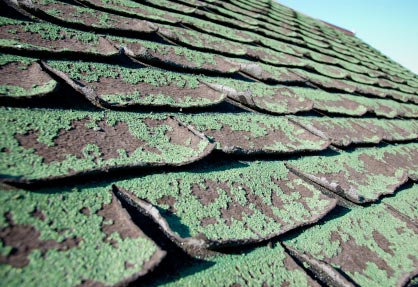
Most Durable Roof to Sun/UV
Believe it or not, the sun can damage your roof. It can cause asphalt shingles to warp and crack. Ultraviolet radiation can break down some roofing materials faster than others. Heat from the sun can dry-up your roof making it more susceptible to hail and fire. Sunlight can also cause colors to fade. In addition, some roofing materials release absorbed heat and reflect sunlight better than others. Below, all of these factors are taken into consideration when ranking the most sun and UV resistant roofing materials.
Color Fading
Metal roofing panels, such as standing seam and corrugated, offer the best resistance to color fading. In fact, our painted metal panels are produced with either Kynar 500® or Hylar 5000® resins which provide superior color retention. This allows us to offer non-pro-rated coating warranties for most applications.
Due to how concrete and clay tiles are made, they often resist color-fading well. Although clay roofing tiles fair better than concrete, you should expect some minor amount of weathering as they age.
Natural slate has a tencency to ‘weather’ and no so much ‘color-fade’ over time. Nonetheless, it can change color, as a result. This is one characteristic of slate that makes it charming.
Although most asphalt shingle manufacturers offer an anti-color-streaking from algae option, none offer a true color-fade-resistant option. Over the lifetime of your asphalt shingles, expect some degree of color fading, albeit minor.
All wood shake varieties fade over time. Western red cedar fades to a grown/gray color. Easter white cedar starts off as a pale yellow/brown, but fades into a gray. This makes it difficult to color-coordinate a wood shake roof with the rest of your house.
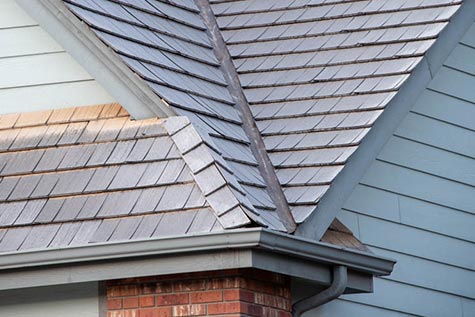
Heat Emittance and Solar Reflectivity
Metal roofing panels perform extremely well with respect to heat emittance (release adsorbed heat) and solar reflectivity (reflects sunlight). This includes any color, not just white or silver. In fact, it is the best roofing material for Colorado, as it helps to cool your home during the hot summer months.
White stone-coated metal shingles and tiles also perform well, although not as well as metal panels. Other colors of metal shingles do not reflect nearly as much heat.
Warping and Cracking
Standing seam metal roofing panels, and stone-coated metal shingles and tiles do not warp. However, they can dent and crack from large hail stones or other large debris. The same is true for slate, and concrete and clay tiles. These roofing materials are much more rigid than asphalt shingles and wood shake, and therefore more durable. Asphalt shingles, on the other hand, are more flexible and as a result are more susceptible to warping. Wood shake is more susceptible than other roofing materials to cracking from large hail stones.
Roofs Most Resistant to Sun/UV:
- Metal (most resistant)
- Concrete Tile
- Clay Tile
- Slate
- Asphalt Shingles
- Wood Shake (least resistant)
Most Durable Roof to Rain
When talking about residential or steep slope roofing materials that are resistant to rain, we’re really talking about which ones that are resistant to the effects of rain, such as warping, swelling, mold, and rot. Metal roofing, such as standing seam and metal shingles, hold-up extremely well to rain because they they do not warp or swell when wet. Metal panels in particular, quickly shed rainwater thanks to its slick surface. Their fewer seams are also beneficial – more seams means more leak opportunites.
Natural slate also does not swell or warp. It is an extremely durable roofing product. Because natural slate can crack or shatter from large objects, such as hail. These cracks make the roof susceptible to rain. Each slate tile is significantly smaller than metal panels. Therefore, more seams, which is not ideal.
The most rain resistant roofing material will shed rainwater quickly, have the fewest seams, and will not absorb water. Clay and concrete tiles are porous and can absorb rainwater. We see more algae growth and mold on clay and concrete roofs than we do on metal. The somewhat coarse texture of clay and concrete roofing tiles won’t shed rain as quickly as metal.
One of the nice things about asphalt shingles is their flexibility. This is potentially a problem, however. Old asphalt shingles have a tendency to curl when there’s poor attic ventilation. This, in turn, leads to moisture build-up, which leads to mold and rot. Most roofing material manufacturers, such as Owens Corning, GAF and CertainTeed, make asphalt shingles that resist algae growth. However, these are not necessarily resistant to mold or rotting.
Wood shake is the worst at resisting mold, mildew, rot, and algae. Unless otherwise stated or requested, new wood shake roofing is not treated and is susceptible to these. Wood naturally absorbs moisture, which leads to rotting, mold, and algae. Also, even if a new wood shake roof is initially treated, it requires additional regularly-scheduled treatments.
Most Rain-Resistant Roofs:
- Metal (most resistant)
- Slate
- Concrete Tile
- Clay Tile
- Asphalt Shingles
- Wood Shake (least resistant)
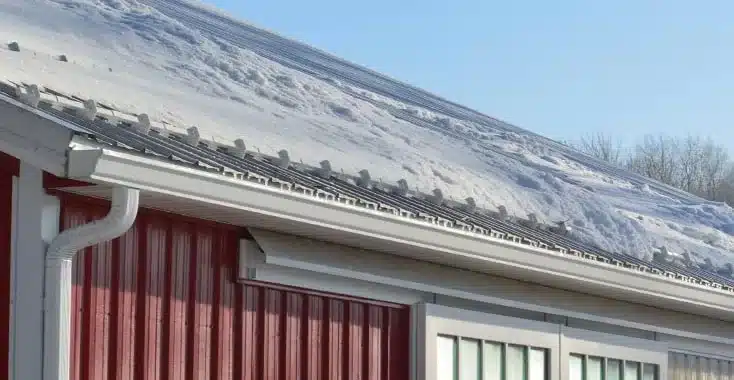
Most Durable Roof to Snow
What dangers or theats does snow present to roofs? Excessive snowfall can be very heavy. How much snow weighs depends upon how wet it is. Here in Colorado, sometimes we get very wet snow in the late fall or early spring. Wet snow is heavier than dry snow. Snow in the dead of winter, however, is often very light and fluffy. The extra weight of snow is a threat to your roof.
Water damage from melting snow is also a danger to your roof. Some roofing materials absorb moisture better than others. Some have more seams than others. More seams equals more opportunities for leaks.
When it comes to shedding snow, standing seam and corrugated panels are the quickest to shed it, thanks to its slick surface. And, because metal doesn’t warp or absorb moisture, it’s also highly resistant to standing snow. Metal roofing panels, such as standing seam and corrugated panels, have fewer seams. Therefore, fewer opportunites for leaks. They can expand and contract in the changing temperatures. This fluctuation can cause breaks or cracks in the sealant on the seams. Therefore, as with any roof, your metal roof should be inspected regularly.
Natural slate also won’t swell or absorb moisture from snow. Although not as slick as metal panels, slate still sheds snow better than asphalt shingles. Slate is heavy, however. With the added weight of wet snow, you’ll want to make sure your house can handle the extra load.
Concrete and clay tiles are also heavy, albeit not as heavy as slate. Concrete and clay tiles have a tendency to absorb moisture, which makes them less than ideal for Colorado. They also become brittle in Colorado’s changing temperatures. As a result, they are more susceptible to cracking and breaking.
Stone-coated metal shingles and tiles have granules on them, which prevents snow from sliding off. From this standpoint, they are not the best for shedding snow. They also have more seams, due to their smaller size, which leads to higher vulnerability. Metal shingles and tiles do not absorb moisture, however.
Due to the rough texture of asphalt shingles, they do not shed snow nearly as quickly as slick metal panels. In addition, as shingles age, they lose their granules, exposing the fiberglass beneath. Now the roof is susceptible to water leaks.
Natural wood shake is the least resistant to snow, here in Colorado. For one, their rough texture hangs-on to show longer than, for example, metal panels. Secondly, wood shake absorbs moisture, and, as a result, is extremely prone to rotting, and mold and plant growth.
Most Snow-Resistant Roofs:
- Standing Seam and Corrugated Metal (most resistant)
- Slate
- Concrete Tile
- Clay Tile
- Stone-Coated Metal Shingles
- Asphalt Shingles
- Wood Shake (least resistant)
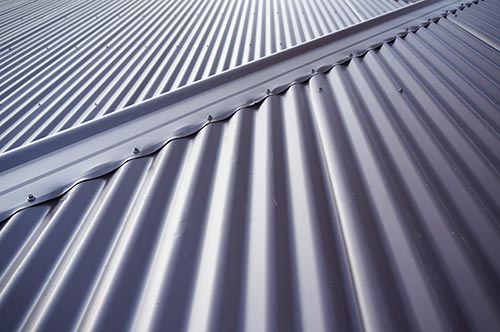
The Bottom Line
The most durable roofing material is corrugated sheet metal. Other metal roofing panel profiles are next in line, such as standing seam. They are the best at shedding snow and rain. Metal roofing panels are the most resistant to color fading. They are the coolest roofing material. Metal is recyclable in just about any area, not just Colorado. It is the most resistant to hail and other debris. Metal is highly resistant to fire. Because of the fewer seams and screws used to secure the panels down, metal roofing is highly wind resistant.
If the most durable roofing material is your number one concern, contact us for a free, non-obligation estimate and inspection. We manufacturer our own standing seam metal roofing panels in-house and we offer non-pro-rated coating warranties for most applications.
Overall longevity
- Standing Seam: 70+ years
- Metal Shingles and Tile: 70+ years
- Natural Slate: 70+ years
- Concrete Tile: 50+ years
- Clay Tile: 50+ years
- Asphalt Shingles: 20-25 years
- Wood Shake: 20 years
